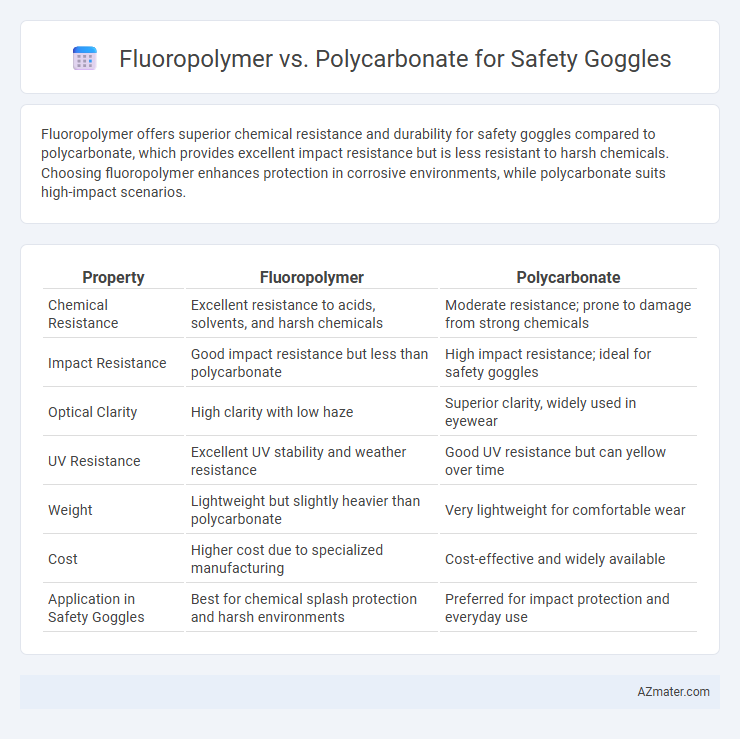Fluoropolymer offers superior chemical resistance and durability for safety goggles compared to polycarbonate, which provides excellent impact resistance but is less resistant to harsh chemicals. Choosing fluoropolymer enhances protection in corrosive environments, while polycarbonate suits high-impact scenarios.
Table of Comparison
| Property | Fluoropolymer | Polycarbonate |
|---|---|---|
| Chemical Resistance | Excellent resistance to acids, solvents, and harsh chemicals | Moderate resistance; prone to damage from strong chemicals |
| Impact Resistance | Good impact resistance but less than polycarbonate | High impact resistance; ideal for safety goggles |
| Optical Clarity | High clarity with low haze | Superior clarity, widely used in eyewear |
| UV Resistance | Excellent UV stability and weather resistance | Good UV resistance but can yellow over time |
| Weight | Lightweight but slightly heavier than polycarbonate | Very lightweight for comfortable wear |
| Cost | Higher cost due to specialized manufacturing | Cost-effective and widely available |
| Application in Safety Goggles | Best for chemical splash protection and harsh environments | Preferred for impact protection and everyday use |
Introduction to Safety Goggle Materials
Fluoropolymer and polycarbonate represent two key materials used in safety goggle manufacturing, each offering unique properties for eye protection. Polycarbonate is renowned for its impact resistance and optical clarity, making it ideal for high-impact environments. Fluoropolymer provides superior chemical resistance and durability, ensuring longevity in harsh chemical exposure conditions.
What Are Fluoropolymers?
Fluoropolymers are a class of high-performance polymers characterized by carbon-fluorine bonds, providing exceptional chemical resistance, thermal stability, and low friction properties, making them ideal for safety goggle lenses and frames. Unlike polycarbonate, which offers high impact resistance and clarity, fluoropolymers excel in harsh chemical environments and UV exposure without degrading. Safety goggles made with fluoropolymers safeguard against corrosive substances while maintaining durability under extreme conditions.
What Is Polycarbonate?
Polycarbonate is a durable, impact-resistant thermoplastic commonly used in safety goggles for its excellent optical clarity and high toughness. It offers superior protection against UV radiation and mechanical hazards, making it ideal for environments requiring reliable eye safety. Compared to fluoropolymers, polycarbonate provides better impact strength but may have lower chemical resistance and scratch resistance.
Optical Clarity Comparison
Fluoropolymer safety goggles provide superior optical clarity due to their high light transmittance and low haze properties, ensuring minimal distortion in vision. Polycarbonate lenses offer good impact resistance but often exhibit slightly lower optical clarity with higher chromatic aberration and haze levels. For applications prioritizing clear, undistorted vision, fluoropolymer materials outperform polycarbonate in maintaining visual accuracy and color fidelity.
Impact Resistance: Which Material Prevails?
Fluoropolymer safety goggles exhibit exceptional chemical resistance but generally offer lower impact resistance compared to polycarbonate lenses, which are renowned for their superior toughness and ability to withstand high-velocity impacts. Polycarbonate's molecular structure absorbs and disperses impact energy efficiently, making it the preferred choice for industrial and sports safety eyewear where protection from debris and collisions is critical. Testing standards such as ANSI Z87.1 highlight polycarbonate's advantage in impact resistance, confirming its dominance over fluoropolymer in protective applications requiring maximum durability.
Chemical Resistance: Fluoropolymer vs Polycarbonate
Fluoropolymer safety goggles exhibit superior chemical resistance compared to polycarbonate, effectively withstanding exposure to aggressive solvents, acids, and bases without degradation. Polycarbonate lenses tend to degrade, craze, or discolor when exposed to strong chemicals, limiting their lifespan and protective capability. Selecting fluoropolymer goggles ensures enhanced durability and consistent optical clarity in harsh chemical environments.
Weight and Comfort Considerations
Fluoropolymer safety goggles are typically lighter and offer greater flexibility, enhancing comfort during prolonged use compared to polycarbonate goggles known for their rigidity and slightly heavier weight. The low density of fluoropolymers contributes to reduced pressure on the face, decreasing fatigue in extended wear scenarios. Polycarbonate goggles, while durable and impact-resistant, may cause discomfort over time due to their heavier frame and less adaptable fit.
Cost Analysis of Fluoropolymer and Polycarbonate Goggles
Fluoropolymer safety goggles typically exhibit higher initial costs compared to polycarbonate ones due to advanced chemical resistance and durability features. Polycarbonate goggles are more cost-effective, offering excellent impact resistance at a lower price point, making them suitable for budget-conscious safety programs. Long-term expenses may balance as fluoropolymer goggles require less frequent replacement in highly corrosive environments, reducing overall maintenance costs.
Durability and Lifespan
Fluoropolymer safety goggles offer superior chemical resistance and UV stability, resulting in enhanced durability in harsh environments compared to polycarbonate goggles. Polycarbonate lenses provide excellent impact resistance but tend to scratch and degrade faster under prolonged exposure to sunlight and aggressive chemicals. The lifespan of fluoropolymer goggles is significantly longer due to their robust surface properties and resistance to environmental stressors, making them a preferred choice for industrial applications requiring extended use.
Choosing the Best Material for Your Safety Goggles
Fluoropolymers offer exceptional chemical resistance, UV protection, and high durability, making them ideal for safety goggles used in harsh environments requiring strong defense against corrosive substances. Polycarbonate provides superior impact resistance and lightweight comfort, suitable for high-impact industrial or construction settings where shatterproof lenses are crucial. Selecting the best material depends on the specific hazards: fluoropolymer goggles excel in chemical splash protection, while polycarbonate goggles are preferred for impact and physical safety.

Infographic: Fluoropolymer vs Polycarbonate for Safety Goggle
 azmater.com
azmater.com